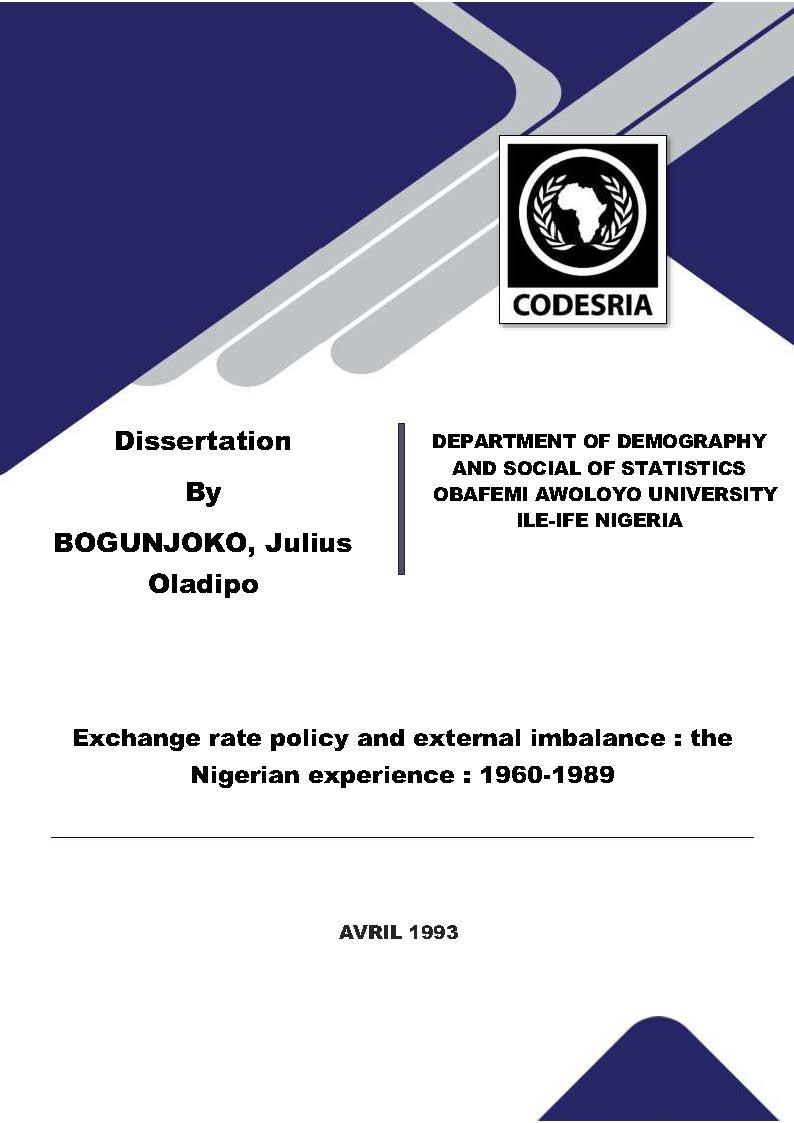Exchange rate policy and external imbalance :: the Nigerian experience : 1960-1989
Keywords:
Exchange rate, foreign exchange control, financial policy, structural adjustment, international payments imbalances,, exchange rate policy, NigeriaSynopsis
Effort has been made in this work to draw a comparative analysis of the alternative exchange rate policy adopted in Nigeria and to ascertain the relative influence of the real exchange rate on Nigerian external trade. The study employed two methods of analysis, namely: historical and econometric methods. Using conventional economic indicators, the study concludes
that the flexible exchange rate, tagged second-tier foreign exchange market (SFEM) has generated a relatively more buoyant external payment account. The Econometric method, on the other band, has confirmed the widespread belief that exchange rate appreciation boosts import consumption and weakens the non-oil experts. Furthermore,the sub-sectoral analysis of imports demand suggests that the exchange rate policy has a differential impact on import components that must be noted in policy decision. To strengthen the role of flexible exchange rate in balance burden of payrnents management, of external adjustment the study recommends that the should be borne, at least partially, by restrictive financial policies, viz: monetary targets should be adhered to as rnuch as possible, so that they will not. be reduced to a mere window dressings and a stumbling black to the potency of SFEM.
Downloads
References
!ullahi, S. H. (1987), "Exchange rate adjustment in The Problem. the solution and the Nigerian
Econbmy under (S)FEM ed. by Attah, Gaskiya Corporation Ltd, Zaria.
Nigeria: cost" in
J. et al,1bakar, S. (1987), "The impact of devaluation facts,
promises,and lesson from other countries" in E.c..QilQIDY......JJ.nder (Sl.Efil.1 ed. by Attah, J. et
al, Corporation Ltd., Zaria.
Nigerian Gaskiyamed Liaquant, ( 1986), "Stabilization Countries", Research Observer. 1986.
policies in Developing Vol. 1 No.1 January, bokhan, Ben ( 1988),Planning, Employment and Incarne Distribution
r.i_a, Kistal Publications Ltd, Lagos.
yi, S. I. ( lfJ75), "Econometric analysis of Import Demand function for Nigeria" Nigerian Journal
of Economies filicLS LC. t uli.e..s (NJESS), VOL.17, No. 3, 1975.
en, P. R. and P. B. Kenen (1980), Asset Market Exchange Rates
. 1.QJJÙ .t.. Qil,Cambridge University Press (CUP).
xander, S. (1952), "Effects of Devaluation on a Trade Balance of payments Adjustment Process"
Economie and Financial
.._f Vol. 21, No. 3.
fowose, O. K. (1983), "The Relevance of Exchange Control in Nigeria's Balance of Payments
Adjustment Process" Econo nd Financial Review, Vol. 25, December.
dele, A. Sesan (1988), Reflecting a Depressed Nigerian Economy Gaskiya Corporation Ltd., Zaria.
stin, E. M. (1978), "The economics of fluctuating exchange rates" in hange rate flexibility, ed.
by Dreyer, J.
S. et al, American Enterprise, Instituts for Public Policy Research, Washington D. C.
ck, S. W. (1976), "Exchange rate policies for the less developed countries", Essays in
International Finance, Princeton University, No. 11, December 1976.
unjoko, J. O. (1990), "Planning for change: The conceptual and Methodological issues in
planning". Unpublish e_d_ term Pa:r;:,e r_ M.Sc Coursework, Department of Economies, Ahmadu Bello
University, Zaria.
vo, G. A. and C.A. Rodgriguez (1977), "A model of exchange rate determination with currency
substitution and rational expectations", Journal of Political Economy, 85: 617 - 626.






